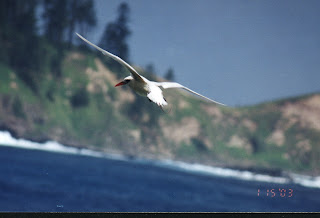Welcome to the first post of this new blog.
Look forward to improved quality and lots of images as I learn along the way.
Why a new blog for Norfolk Island? I hear you ask.
MANY people in the local community as well as visitors to the island and researchers, are interested in keeping abreast of what's happening around Norfolk Island in the natural world, on land and sea.
This blog is being created to provide a focal point for observations, and provide answers to questions, or at least help readers take the right direction to find their answers.
Websites already exist to provide lists of species etc, but it is intended that this site will provide regularly updated current information about the many interesting happenings in and around the island group.I welcome any observations or questions and hope that together we can all learn more about our wonderful and unique environment through sharing our experiences and observations.
BIRDS
... will be a feature as I spend a considerable amount of time outdoors, in the forest and by the wetlands keeping an eye on the comings and goings of migratory species as well as the resident ones. I have the good fortune to often be accompanied by visitors in search of the island's unique species, and we discover new and unexpected things all the time.
 In just the last week we have seen at least one (and possibly 3) Long-tailed Cuckoos, 2 black cormorants, a Pied Stilt, 5 Bar-tailed Godwits, heard Shining Bronze-cuckoos and seen an increasing number of Ruddy Turnstones (17) and Golden Plovers (44). One Tattler was also seen but not identified to species.
In just the last week we have seen at least one (and possibly 3) Long-tailed Cuckoos, 2 black cormorants, a Pied Stilt, 5 Bar-tailed Godwits, heard Shining Bronze-cuckoos and seen an increasing number of Ruddy Turnstones (17) and Golden Plovers (44). One Tattler was also seen but not identified to species. Some of the regular breeding seabird migrants are already feeding chicks; Tasman boobies, White terns and White-capped Noddies in particular are obvious. We heard the first returned Wedge-tailed Shearwater (Ghostbird) on 19 October, the Red-tailed Tropicbirds have acome ashore and it won't be long before the Frigatebirds turn up while these chicks are being fed around the coast.
Some of the regular breeding seabird migrants are already feeding chicks; Tasman boobies, White terns and White-capped Noddies in particular are obvious. We heard the first returned Wedge-tailed Shearwater (Ghostbird) on 19 October, the Red-tailed Tropicbirds have acome ashore and it won't be long before the Frigatebirds turn up while these chicks are being fed around the coast.WHALE MIGRATIONS
have been under observation for the last 2 months especially, with the annual visit of our whale researchers from Brisbane and Byron Bay. Some new species records for the area have been identified in that time. Their research is mainly concentrating on Humpback Whales, but all sightings of whales and dolphins are of interest. At this time of year the whales are returning from their calving grounds in the warm waters to the north, and travel slowly back to their feeding grounds in Antarctica while the calves put on enough weight to save them from freezing in the cold Southern Ocean waters.
Until next time.

Great initiative Marg! Will look forward to reading as much as you can post about the nature of Norfolk.
ReplyDeleteLinda and Langdon E
Thank you heaps Margaret for sending me the link. It will give me great pleasure to stay "in touch" (albeit from a distance)with your paradise, which as you know is also my paradise too ........ Z2
ReplyDeleteHi Marg,you have been busy. I look forward to checking in regularly and keeping up to date with happenings on Norfolk.
ReplyDeleteRegards
John
Great Blog site Marg - really great to read. Looking forward to reading you regularly! Lisa
ReplyDeleteLaunch pad in place for more great things!
ReplyDeleteThose cormorants look little black cormorants (Phalacrocorax sulcirostris) to me... Nice one with the pectoral sandpiper... and especially the long-tailed cuckoo... any feathers from that one?
ReplyDeleteWhat a great way to utilise and share your knowledge. Look forward to further news of
ReplyDeletethe yella Bloody Bridge parrot.
Congratulations Marg, a fine way not only to provide 'flights' of feathered infomation, but also to promote Norfolk to a greater audience around the world! :)
ReplyDelete